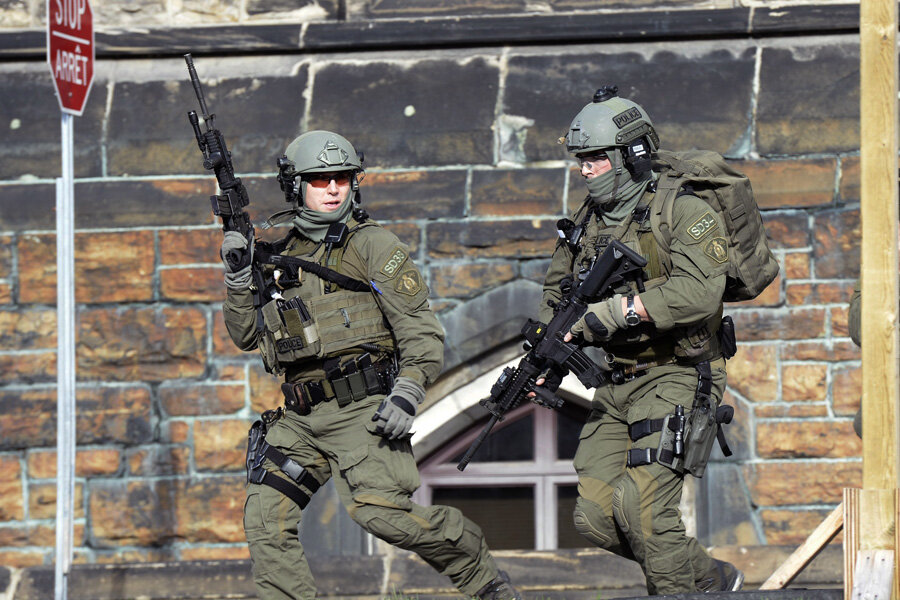Canada shooting: Friend says suspect was 'erratic,' spoke often of Satan
Loading...
Details are beginning to emerge from the deadly shooting Wednesday on Ottawa's Parliament Hill, in which a gunman opened fire on the Canadian War Memorial and inside the Parliament building. Two people were killed, including the shooter.
Canadian officials have identified the gunman as Michael Zehaf-Bibeau, a 32-year-old Canadian man with a minor criminal record. Dave Bathurst, a friend of Mr. Zehaf-Bibeau, told The Globe and Mail he had met him at a mosque in British Columbia, where he worked as a miner. Zehaf-Bibeau also served one day in jail for making threats in a 2011 incident in Montreal that his lawyer described to The Globe and Mail as "fairly minor and fairly bizarre."
Mr. Bathurst said Zehaf-Bibeau did not appear to be an extremist, but was "erratic" and exhibited strange behavior. "We were having a conversation in a kitchen, and I don’t know how he worded it: He said the devil is after him," Bathurst said, adding that Zehaf-Bibeau talked frequently about Shaytan, or Satan, being a presence in the world. "I think he must have been mentally ill," Bathurst said.
Bathurst added that he last saw Zehaf-Bibeau six weeks ago, when his friend said he planned to travel to Libya to study Islam. Bathurst challenged him not to go for "something else," but Zehaf-Bibeau insisted he only wanted to study.
Zehaf-Bibeau was blocked from traveling abroad by the federal government, however, over concerns that he was attempting to join up with foreign extremists.
The Globe and Mail notes that a 2011 Washington Times report suggests that Zehaf-Bibeau's father, Belgasem Zehaf, may have himself fought in Libya for rebels seeking to topple Muammar Qaddafi.
Government officials have yet to confirm or deny that Zehaf-Bibeau was the only gunman involved in the shooting Wednesday, which began around 9:52 a.m., when a man armed with a long gun opened fire on a soldier guarding the Canadian War Memorial across the street from Parliament. The man then ran across the road and into Parliament's Centre Block building, where Canada's two major parties were caucusing.
The soldier, now identified as Canadian Army reservist Cpl. Nathan Cirillo of Hamilton, Ont., was critically wounded in the attack, and was taken to a nearby hospital. He died from his wounds.
Inside the Centre Block, a gunman entered into a firefight with several security personnel, with dozens of shots being fired before he was killed. At least two other persons were injured in the shooting, though they were reported to be in stable condition.
Wednesday saw several unconfirmed reports of more than one gunman, and shootings beyond the two incidents on and in Parliament Hill. At present, Zehaf-Bibeau is the only confirmed shooter, and the shootings at the memorial and inside Centre Block are the only confirmed attacks, CTV reports. Reuters notes that Canadian officials have not confirmed that Zehaf-Bibeau was the man who shot Corporal Cirillo.
Reuters reports that the attack highlighted a glaring lack of security at Parliament Hill, since the gunman was able to walk right into Centre Block without being challenged.
To enter its main building, the Centre Block, which houses the House of Commons, Senate and the prime minister's office, a visitor need only open the glass-and-metal front door. Inside, there are security guards but no gate or barrier preventing entry to the ornate marble hallways.
Parliamentary staff or visitors with credentials, such as journalists, can proceed past the guards without further checks.
Other visitors are sent back outside to enter at another nearby door, where they must pass through metal detectors and are restricted to designated areas. Children routinely visit parliament with school groups or their families.
Christian Leuprecht, a security expert at the Royal Military College of Canada and Queen's University, in Kingston, Ontario, noted that "taller walls and deeper moats" may only result in attackers choosing less fortified targets. "If you harden one target, they'll pick a softer target. If you make it harder to attack Parliament, they may go after the Supreme Court. Simply thinking about it as a physical security problem misses the bigger problem of how we provide effective security," he said.
In an analysis for CBC News, Brian Stewart writes that in fact, "we've known this day was coming." The challenge for Canada, he argues, is to not respond fearfully or out of paranoia, but rather in a way that returns the country to normalcy as soon as possible.
The pressing issue for the country right now is how well we respond to the shock of these events, and at the same time how we can best use our police and intelligence assets to thwart future attacks.
There will be changes to the landscape, of course, and we will certainly see more guards around potential targets in both government and private sectors, while below the surface, more counterterrorism surveillance will be launched.
But we shouldn't want too much to change. Government, police, and our intelligence agency, CSIS, have together long-studied how society should react after such shock attacks and the underlying theme comes down that word "resilient."
"A resilient Canada is one that is able to mitigate the impacts of a terrorist attack, ensuring a rapid return to ordinary life," the official counterterrorism strategy declares.








